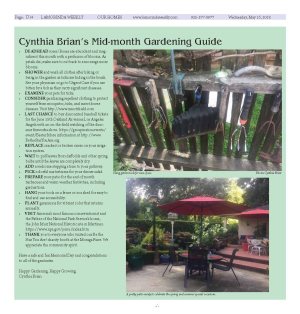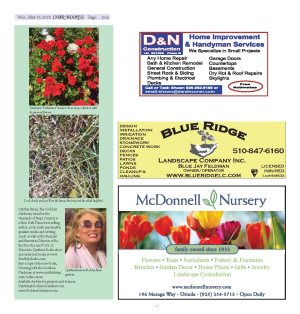|
|
Published May 16th, 2018
|
Digging Deep with Cynthia Brian
|
| The intriguing life of ladybugs |
| By Cynthia Brian |
 |
| Barley and weeds infested with aphids are a habitat for lady beetles. Photos Cynthia Brian |
"Ladybug, ladybug, fly away home. Your house is on fire and your children will burn." - Nursery Rhyme
 If you were like me, when you were a child, this ladybug nursery rhyme was one of your favorites. I could imagine the tiny red beetle with the black dots on her back swooping in like a great eagle to rescue her babies. As an adult, of course, I know better than to wish for the ladybugs to fly away home. I want them to make my garden their home to keep the aphids away.
If you were like me, when you were a child, this ladybug nursery rhyme was one of your favorites. I could imagine the tiny red beetle with the black dots on her back swooping in like a great eagle to rescue her babies. As an adult, of course, I know better than to wish for the ladybugs to fly away home. I want them to make my garden their home to keep the aphids away.
 Every year around this time you'll find containers of ladybugs for sale at garden centers. Often when you get these ladybirds home (yes, they are also known as ladybirds or ladybug beetles) they disappear as soon as you open the carton, leaving you wondering where they went and why. The answer is simple. Ladybugs only stay in a habitat that provides food and their main cuisine is aphids. If your garden doesn't have aphids, you may rejoice that these red angels have flown to liberate another's garden. In one year, a single ladybird will eat 5,000 aphids or more.
Every year around this time you'll find containers of ladybugs for sale at garden centers. Often when you get these ladybirds home (yes, they are also known as ladybirds or ladybug beetles) they disappear as soon as you open the carton, leaving you wondering where they went and why. The answer is simple. Ladybugs only stay in a habitat that provides food and their main cuisine is aphids. If your garden doesn't have aphids, you may rejoice that these red angels have flown to liberate another's garden. In one year, a single ladybird will eat 5,000 aphids or more.
 A most exciting experience transpired in my daughter's garden and I was fortunate to witness the metamorphosis. As Heather prepared her yard for a party she began to cut a field of wild barley and weeds when she noticed many numerous living things. She crouched down on her knees for a closer look to see a plethora of bugs in a variety of stages including ladybugs. That's when she called me. She didn't want to disturb the life cycle of what she ascertained were breeding ladybugs.
A most exciting experience transpired in my daughter's garden and I was fortunate to witness the metamorphosis. As Heather prepared her yard for a party she began to cut a field of wild barley and weeds when she noticed many numerous living things. She crouched down on her knees for a closer look to see a plethora of bugs in a variety of stages including ladybugs. That's when she called me. She didn't want to disturb the life cycle of what she ascertained were breeding ladybugs.
 My first question to her was "where are the aphids" to which she answered that she hadn't seen any. I went to the field and from where I stood, I couldn't see anything either, but as soon as I knelt down for an up close and personal look, I was mesmerized. I had never observed ladybugs in their egg, larvae, pupa, or youngster forms. Various stems were hatching at different times. Yellow eggs hung next to larvae that resembled a caterpillar alligator. Then the next stage of pupa was orange with black dots. Juveniles were an orange-yellow without black spots. Adults could be seen on the same stem. The field was alive with birthing ladybugs.
My first question to her was "where are the aphids" to which she answered that she hadn't seen any. I went to the field and from where I stood, I couldn't see anything either, but as soon as I knelt down for an up close and personal look, I was mesmerized. I had never observed ladybugs in their egg, larvae, pupa, or youngster forms. Various stems were hatching at different times. Yellow eggs hung next to larvae that resembled a caterpillar alligator. Then the next stage of pupa was orange with black dots. Juveniles were an orange-yellow without black spots. Adults could be seen on the same stem. The field was alive with birthing ladybugs.
 Nearby oleanders were cloaked with aphids as were many of the weeds. The four-stage life cycle of the ladybug begins with the female laying a dozen to 50 eggs after mating onto a plant that will be rich with food. Although we call them ladybugs, there are both female and male ladybeetles. In one season a female may produce 1,000 or more eggs, some of which will become a meal for the larvae. The black and spotted larvae emerge from the eggs in only about four days feeding voraciously on aphids, insect eggs, mites, and other bugs. Resembling alligator like caterpillars, they'll eat 400 or more aphids before they pupate in the next two to three weeks. The pupal stage lasts for three to 12 days when the adult beetles metamorphic into the ladybugs that we recognize.
Nearby oleanders were cloaked with aphids as were many of the weeds. The four-stage life cycle of the ladybug begins with the female laying a dozen to 50 eggs after mating onto a plant that will be rich with food. Although we call them ladybugs, there are both female and male ladybeetles. In one season a female may produce 1,000 or more eggs, some of which will become a meal for the larvae. The black and spotted larvae emerge from the eggs in only about four days feeding voraciously on aphids, insect eggs, mites, and other bugs. Resembling alligator like caterpillars, they'll eat 400 or more aphids before they pupate in the next two to three weeks. The pupal stage lasts for three to 12 days when the adult beetles metamorphic into the ladybugs that we recognize.
 The adults will stay in a garden as long as aphids or other insects they munch on prevail. When temperatures drop below 55 degrees, ladybugs will hibernate for up to nine months to survive the cold. Once the weather warms, these dynamos begin their feeding frenzy once again until their lifespan of about one year reaches its limits.
The adults will stay in a garden as long as aphids or other insects they munch on prevail. When temperatures drop below 55 degrees, ladybugs will hibernate for up to nine months to survive the cold. Once the weather warms, these dynamos begin their feeding frenzy once again until their lifespan of about one year reaches its limits.
 If you have lots of aphids in your garden, you have a prime habitat for ladybugs. Get up close, look under leaves, and watch the fascinating cycle of one of our favorite garden friends. Don't fret when the ladybeetles fly away home because it usually means that your landscaping is now aphid free.
If you have lots of aphids in your garden, you have a prime habitat for ladybugs. Get up close, look under leaves, and watch the fascinating cycle of one of our favorite garden friends. Don't fret when the ladybeetles fly away home because it usually means that your landscaping is now aphid free.
 Cynthia Brian's Mid-month Gardening Guide
Cynthia Brian's Mid-month Gardening Guide
 DEADHEAD roses! Roses are abundant and magnificent this month with a profusion of blooms. As petals die, make sure to cut back to encourage more blooms.
DEADHEAD roses! Roses are abundant and magnificent this month with a profusion of blooms. As petals die, make sure to cut back to encourage more blooms.
 SHOWER and wash all clothes after hiking or being in the garden as ticks are hiding in the brush. See your physician or go to Urgent Care if you are bitten by a tick as they carry significant diseases.
SHOWER and wash all clothes after hiking or being in the garden as ticks are hiding in the brush. See your physician or go to Urgent Care if you are bitten by a tick as they carry significant diseases.
 EXAMINE your pets for ticks.
EXAMINE your pets for ticks.
 CONSIDER purchasing repellent clothing to protect yourself from mosquitos, ticks, and insect-borne diseases. Visit http://www.insectshield.com
CONSIDER purchasing repellent clothing to protect yourself from mosquitos, ticks, and insect-borne diseases. Visit http://www.insectshield.com
 LAST CHANCE to buy discounted baseball tickets for the June 15th Oakland A's versus Los Angeles Angels with an on-the-field watching of the dinosaur fireworks show.
https://groupmatics.events/event/Bestar More information at
http://www.BetheStarYouAre.org
LAST CHANCE to buy discounted baseball tickets for the June 15th Oakland A's versus Los Angeles Angels with an on-the-field watching of the dinosaur fireworks show.
https://groupmatics.events/event/Bestar More information at
http://www.BetheStarYouAre.org
 REPLACE cracked or broken risers on your irrigation system.
REPLACE cracked or broken risers on your irrigation system.
 WAIT to pull leaves from daffodils and other spring bulbs until the leaves are completely dry.
WAIT to pull leaves from daffodils and other spring bulbs until the leaves are completely dry.
 ADD a welcome stepping stone to your pathway.
ADD a welcome stepping stone to your pathway.
 PICK colorful nasturtiums for your dinner salad.
PICK colorful nasturtiums for your dinner salad.
 PREPARE your patio for the end of month barbecues and warm weather festivities, including graduations.
PREPARE your patio for the end of month barbecues and warm weather festivities, including graduations.
 HANG your tools on a fence or in a shed for easy to find and use accessibility.
HANG your tools on a fence or in a shed for easy to find and use accessibility.
 PLANT geraniums for vibrant color that returns annually.
PLANT geraniums for vibrant color that returns annually.
 VISIT America's most famous conservationist and the Father of the National Park Service's home, the John Muir National Historic site in Martinez.
https://www.nps.gov/jomu/index.htm
VISIT America's most famous conservationist and the Father of the National Park Service's home, the John Muir National Historic site in Martinez.
https://www.nps.gov/jomu/index.htm
 THANK you to everyone who visited our Be the Star You Are! charity booth at the Moraga Faire. We appreciate the community spirit.
THANK you to everyone who visited our Be the Star You Are! charity booth at the Moraga Faire. We appreciate the community spirit.

 Have a safe and fun Memorial Day and congratulations to all of the graduates.
Have a safe and fun Memorial Day and congratulations to all of the graduates.

 Happy Gardening. Happy Growing.
Happy Gardening. Happy Growing.
 Cynthia Brian
Cynthia Brian


|
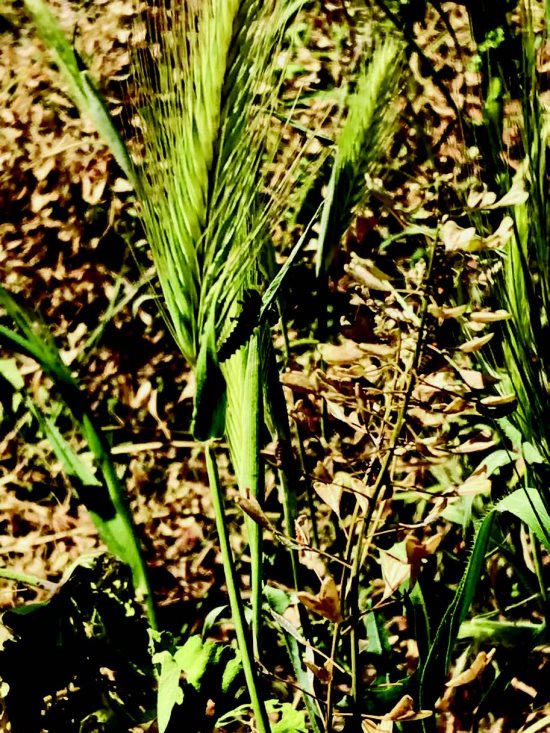 |
| Ladybug larva resembles an alligator caterpillar on barley. |
 |
| Hang garden tools for ease of use. Photos Cynthia Brian |
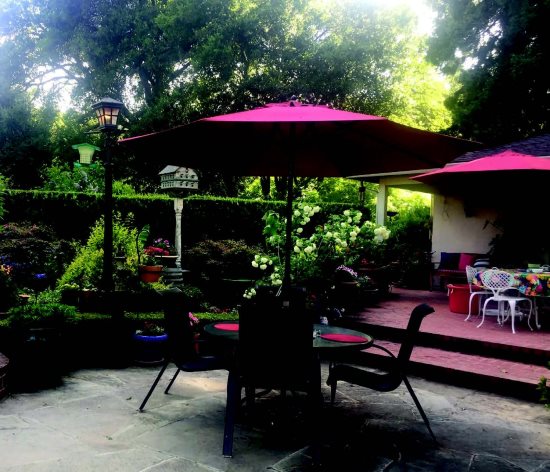 |
| A pretty patio ready to celebrate the spring and summer special occasions. |
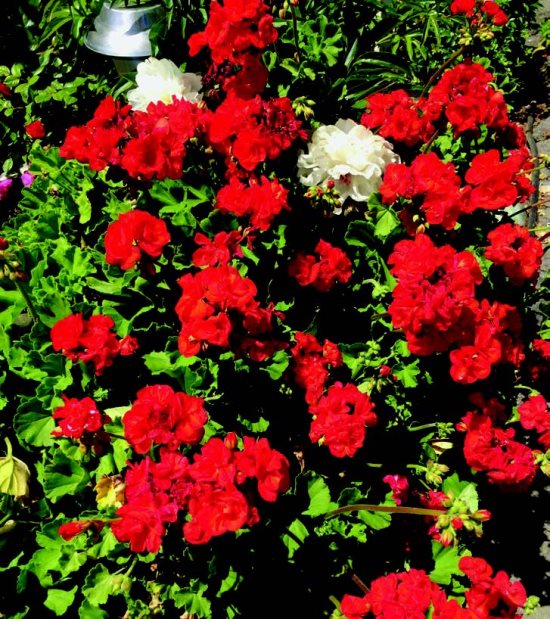 |
| Geranium "Distinction" needs to be in every collection with its pure red flowers. |
 |
| Look closely
and you'll see the larva, the teen, and the adult ladybird. |
 |
| Cynthia Brian in the John Muir gardens. Cynthia Brian, The Goddess Gardener, raised in the vineyards of Napa County, is a New York Times best-selling author, actor, radio personality, speaker, media and writing coach as well as the Founder and Executive Director of Be the Star You Are1(r) 501 c3. Tune into Cynthia's Radio show and order her books at
www.StarStyleRadio.com. Buy a copy of the new book, Growing with the Goddess Gardener, at www.cynthiabrian.com/online-store. Available for hire for projects and lectures.
Cynthia@GoddessGardener.com
www.GoddessGardener.com
|
|
|
|










